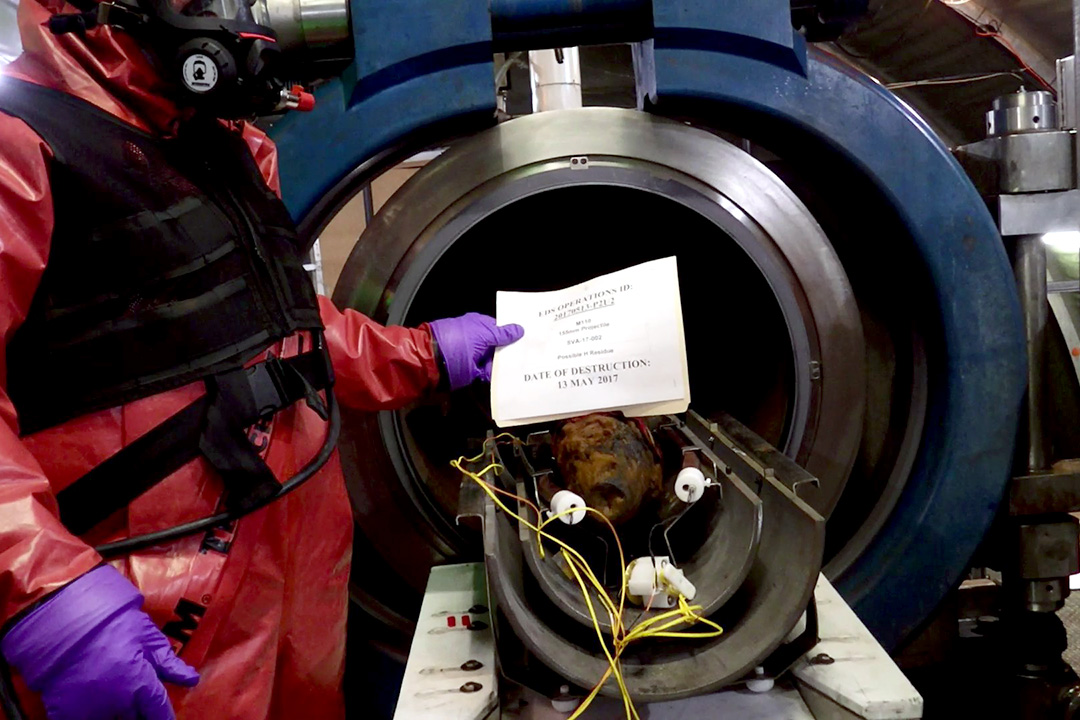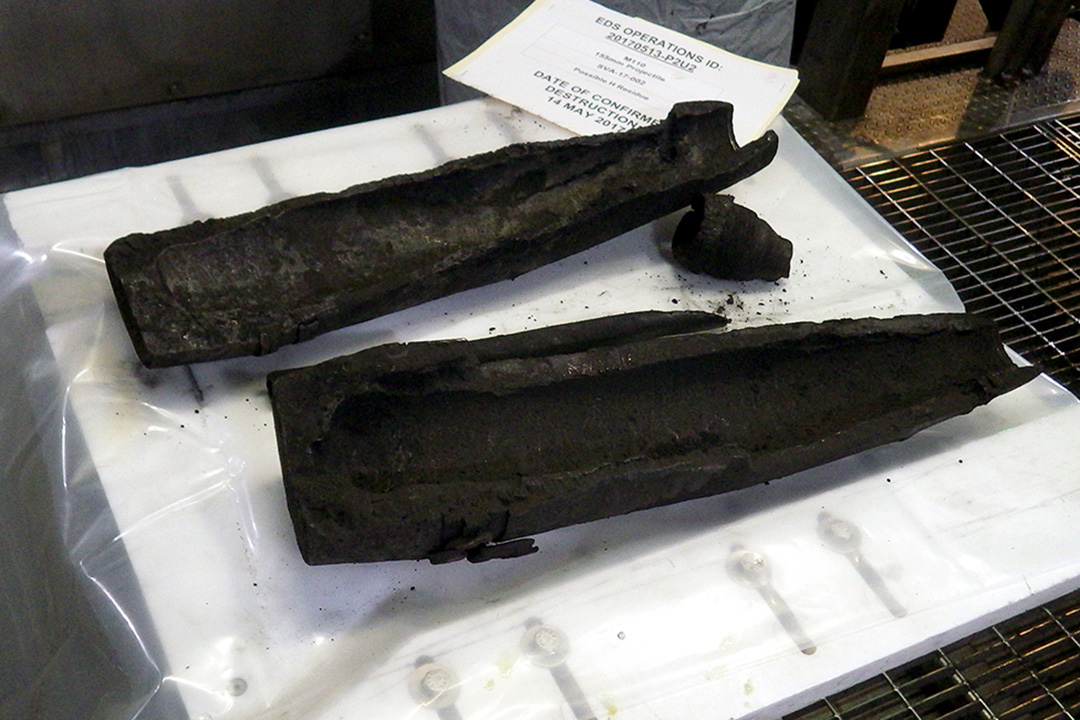// NEWS RELEASE
ECBC Completes Two Field Operations Projects
Destruction operation and environmental investigation performed at separate Illinois sites.
CCDC Chemical Biological Center Public Affairs | July 6th, 2017
ECBC Completes Two Field Operations Projects
Destruction operation and environmental investigation performed at separate Illinois sites.
DEVCOM CBC Public AffairsJuly 6th, 2017

A CBARR operator prepares a chemical munition for destruction using the EDS during operations at the former Savanna Army Depot in May.
ECBC’s Chemical Biological Application and Risk Reduction (CBARR) unit completed field operations this spring at two former military installations in the state of Illinois. A destruction operation was performed at the former Savanna Army Depot, a follow-up action to a previous phase of remediation that occurred last year. And an environmental investigation concluded at the former Chanute Air Force Base. Both projects are part of remediation plans by the U.S. Army Corps of Engineers to environmentally restore and repurpose the unused facilities.
Savanna EDS
In mid-May, a 155mm mustard round was destroyed at the former Savanna Army Depot with an explosive destruction system (EDS) operated by a crew from CBARR. The munition was recovered during an environmental investigation in December 2016.
ECBC’s CBARR unit supported the U.S. Army Engineer Support Center Huntsville (USAESCH) in the investigation of three mustard burn areas at the former Army depot in 2016. CBARR’s team provided continuous air monitoring during intrusive operations at the site. During the initial investigation, two items were found. The first item, it was determined, contained no chemical agent and was disposed in accordance with local policies and procedures.
But when this second item was discovered during the investigation, said Project Manager Laura Graham, an indication from the Miniature Continuous Air Monitoring Systems, known as MINICAMS, alerted workers to the potential of a chemical-filled munition. After thorough assessment, it was determined that the munition contained the chemical agent HD.
“We used the field investigation data along with the assessment results and decided to treat it as a “leaking” munition,” Graham said. “This determination was critical in the development of the plans and procedures required to conduct the destruction operation safely.”
Although further analysis determined that the munition was not leaking, ECBC’s CBARR team developed its operational plan as if the item was leaking to ensure additional safety measures were included.

“The CBARR team of operators, engineers and safety professionals use all information available but sometimes is best to take the most conservative path for an operation,” Graham said. “In this case, we all felt that we would be assured of no surprises if we planned to handle the munition as if it were leaking.”
The destruction was conducted using the P2U2 EDS owned by the U.S. Army Chemical Materials Activity, which had overall responsibility for the operations. CBARR personnel serve as operators and maintainers for all of the EDS systems.
The P2U2 is one of the original EDS units, and unlike its updated versions, it uses electric heater bands to heat the vessel. This is a slower process, Graham said, and as a result, the operation takes two days to process the chemical munition.
The initial site visit for the EDS team was held in January 2017. CBARR’s first crew arrived for site setup on April 17. A preoperational survey took place May 9-11. Destruction operations occurred May 13-14, and the site was closed by May 25.
Savanna is located in northern Illinois on the Iowa border. Located on the banks of the Mississippi River, remediated portions of the depot have been turned into public wildlands.
Chanute Air Force Base
A project team of U.S. Air Force and U.S. Army, including ECBC, conducted the second phase of an environmental investigation at the former Chanute Air Force Base in Rantoul, Illinois, earlier this year to determine whether past chemical agent training activities have impacted the environment.
The first phase of the investigation was completed in November 2016 when the project team used ground scanning equipment to identify anomalies buried in the ground, initially suspected to be containers once used to ship and store training materials.
The project team evaluated the data collected and selected 100 anomalies for further investigation in the second phase of the project conducted in early May, which included soil sample analysis performed by ECBC laboratories, said Project Manager Satchell Doyle Jr. It was determined that the metal was construction materials such as metal rebar, likely associated with the demolition of numerous buildings that were constructed in the area after training activities occurred, according to information provided by the Air Force Civil Engineer Center (AFCEC). No items related to former training activities were found and no contamination is present, said the AFCEC.
The U.S. Army Combat Capabilities Development Command (DEVCOM) leads in the discovery, development and delivery of technology-based capabilities to enable Soldiers to win our nation’s wars and come home safely. DEVCOM is a major subordinate command of the U.S. Army Futures Command. The DEVCOM Chemical Biological Center is the Army’s principal research and development center for chemical and biological defense technology, engineering and field operations. The DEVCOM Chemical Biological Center is headquartered at Aberdeen Proving Ground, Maryland.
